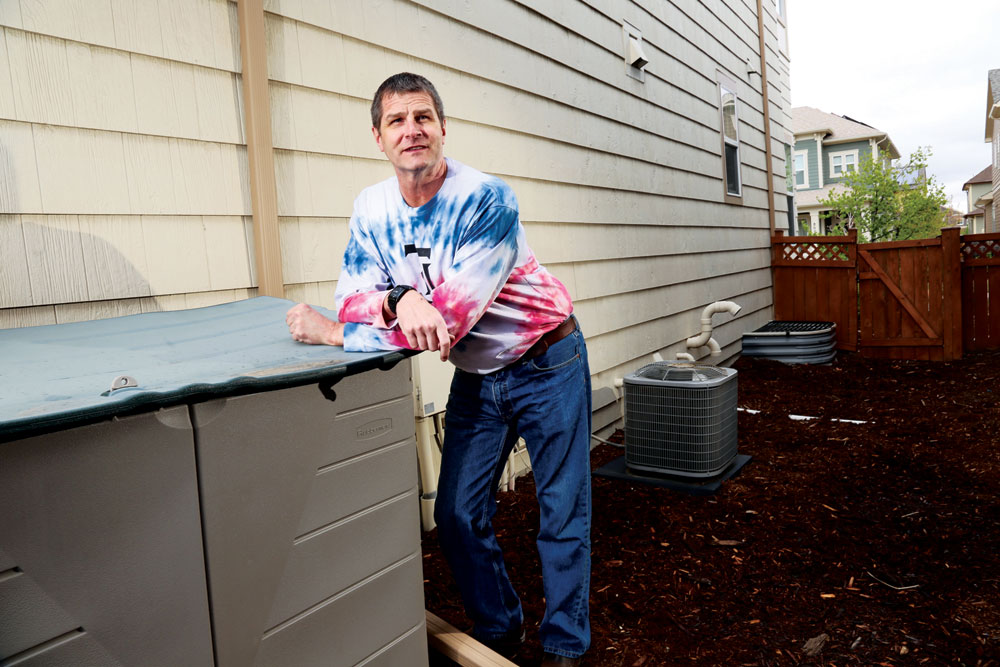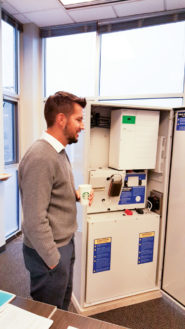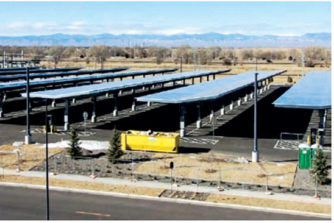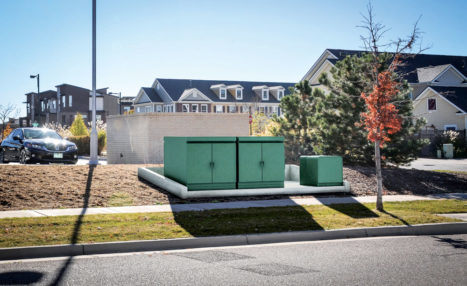
Dennis Campbell stands where the Xcel battery will be installed this month in the side yard of his home in the Central Park neighborhood. “Anything that saves money, I’m all in,” says Campbell.
Local residents will have a front-row seat in a two-year Xcel Energy pilot program testing the role of energy storage batteries at their homes. Six homeowners in the North Central Park and Eastbridge neighborhoods have been selected to participate in the pilot project and will have the opportunity to take ownership of the batteries when the project is over. The batteries are being studied for their use as back-up power in homes and for the impact of more rooftop solar power going into the energy

Tyler McGrath, Xcel’s distribution project manager, explains the features of the Sunverge battery at a public open house in November.
grid.
This residentially scaled project is getting underway at the same time a similar pilot project will test battery storage serving commercial uses: the DIA-owned parking lot at the 61st and Peña Station and Panasonic’s new operations hub building located just east of that A Line station.
Each of these efforts reflects an exploration by Xcel Energy of ways to incorporate more renewable energy into their portfolio and at the same time protect the electric grid.
Meanwhile, in an entirely private transaction, Thrive Home Builders will be providing 55 Beeler Park single-family homes with a Tesla Powerwall 2.0 battery as a standard option (See Stapleton Homes First in the Country to Offer Tesla Power Suite.)
The Stapleton and Peña Station installations will allow testing at two different scales (residential and commercial) and differing levels of complexity. In Stapleton, single batteries placed on residential lots are being tested. At Peña Station, project partners include Xcel, Panasonic and Denver International Airport. A large carport solar PV system as well as a commercial rooftop solar PV system work together with a single, large battery energy storage system to form a microgrid that aids incorporating more solar energy in Colorado’s grid, provides resilience through backup power, and delivers multiple services that support Xcel’s grid. The Peña project is already operational while installation of the Stapleton residential batteries will begin in May. Tyler McGrath, project manager for Xcel, points out that almost all of the project team working on Stapleton also has some part in the Peña Station project. Stapleton was selected for participation in the project due to the high penetration of rooftop solar PV (approximately 20 percent), says Beth Chacon, Xcel’s director of grid storage and emerging technologies. She explains that solar PV penetration reaches a “tipping point” at 35 percent, leading to issues such as voltage spikes and system flickers that can not only be annoying but can damage electrical distribution system equipment.
Thumbnail descriptions of the two project sites are provided below:

Overview of Peña Station site. The “Islanding Switch” manages the energy system, connecting or disconnecting the microgrid from the main grid.
Stapleton Neighborhoods—Central Park North, Eastbridge
Valued at $15,000–$20,000, the 15.5 kW batteries will be provided free of charge to the participating residents. At the end of the two-year pilot, the homeowners can have the batteries removed or take ownership of them throughout their expected 10-year life span.
The batteries will be placed outdoors near garages and paired with the pre-existing rooftop solar systems.
Batteries will be wired to a back-up electrical panel that supports customer-selected items for when the power goes down, such as lights, a refrigerator and select wall outlets.
Six utility-scale batteries will be installed in the public street right-of-way near the residential installations. This enables the pilot to evaluate how residential batteries will interact with the utility meters.
The pilot will test the security of the utility-scale batteries, which were constructed with robust materials and locking mechanisms but made as inconspicuous as possible.
Peña Station

The 1 MW/2 MWh lithium battery supplied by Younicos, owned by Xcel Energy and maintained by Panasonic.
The parking lot at 61st and Peña Blvd. has a 1.3 megawatt (mWdc) carport solar installation owned and operated by Xcel Energy (under a lease with DIA, which owns the carports).
Panasonic is installing a 259 kWdc rooftop solar PV array atop its corporate office building.
The two solar installations will connect to a 1-megawatt lithium ion battery system, creating their own microgrid. An “intelligent energy management” system (the islanding station) will connect or disconnect the microgrid from the main grid based on factors such as overall energy loads, power production from the PV arrays, energy prices and power outages.
The micro-grid will serve what Panasonic calls Peña Station NEXT, a transit-oriented development district that is testing a wide range of new technologies including: smart street lighting, ultra-fast community Wi-Fi, smart parking, electric vehicle charging stations, autonomous electric vehicle shuttles, a smart bus shelter, environmental sensing and interactive digital signage.

The Peña Station project combines solar photovoltaic from carports in DIA’s parking lot and rooftop solar from the Panasonic headquarters buildings.
Project Goals
Xcel has a state-mandated renewable energy goal of 30 percent by the year 2020 (it was 23 percent of Xcel Energy’s mix in Colorado in 2015). The two-year test period is intended to determine optimal settings for the batteries and to evaluate wider deployment of the batteries. Goals for both projects are:
Integrating more solar power into the electric grid;
Minimizing the impact of fluctuations in solar PV output;
Having batteries store excess energy when solar generation is high and to dispatch energy later in the day;
Reducing peak demand for the grid; and
Charging batteries at times prices are low and discharging them when prices are high.
A white paper co-authored by Panasonic, Xcel and Younicos, describes the 61st and Peña project as a “multi-use battery energy storage system (that) provides grid and customer services through a public-private partnership.” The paper asserts that the existing electric grid, “built to provide a one-way flow of power from centralized, predominately fossil-fueled power stations to distant customers – is giving way to a rapidly emerging new system…that enables a two-way flow of information, services and value.”

Photo-simulation of a “utility-scale” battery to be installed in street rights-of-way or easements in Stapleton’s North Central Park and Eastbridge neighborhoods. Final configuration and design may be subject to change due to engineering or other factors.
Key to this potential are the batteries which Panasonic’s Peter Bronski refers to as the “Swiss army knife” of the power grid, capable of doing many things for many stakeholders. Chacon of Xcel describes these batteries as an “emerging technology that is becoming more affordable to use in the utility industry. We want to better understand how the technology can play a role in supporting our distribution grid.” Bronski said the “successful operation of the grid comes down to the balance of supply and demand. So now as we add more solar to the equation, the question becomes how do we best balance that with the demand side. And energy storage systems are a nimble and very capable way of doing that.”



0 Comments